Isolation Improvement of Parasitic Element-Loaded Dual-Band MIMO Antenna for Mm-Wave Applications
Abstract
:1. Introduction
2. Single Element Wideband Antenna Operating at 28/38 GHz
2.1. Antenna Design
2.2. Antenna Design Stages
2.3. Single Element Antenna Results and Discussions
2.3.1. Measured and Simulated S-Parameter
2.3.2. Measured and Simulated Gain
2.3.3. Measured and Simulated Radiation Pattern
3. MIMO Configuration of Proposed Antenna
3.1. MIMO Antenna Design Procedure
3.2. MIMO Antenna Performance Parameter
3.2.1. Reflection Coefficient
3.2.2. Transmission Coefficient
3.2.3. Radiation Pattern
3.2.4. Envelop Correlation Coefficient (ECC)
3.2.5. Diversity Gain (DG)
3.2.6. Channel Capacity Loss (CCL)
3.2.7. Mean Effective Gain (MEG)
4. Conclusions
Author Contributions
Funding
Institutional Review Board Statement
Informed Consent Statement
Data Availability Statement
Conflicts of Interest
References
- Fatah, S.Y.A.; Hamad, E.K.; Swelam, W.; Allam, A.M.M.A.; Sree, M.F.A.; Mohamed, H.A. Design and implementation of UWB slot-loaded printed antenna for microwave and millimeter wave applications. IEEE Access 2021, 9, 29555–29564. [Google Scholar] [CrossRef]
- Ibrahim, A.A.; Abo Sree, M.F. UWB MIMO antenna with 4-element, compact size, high isolation and single band rejection for high-speed wireless networks. Wirel. Netw. 2022, 28, 3143–3155. [Google Scholar] [CrossRef]
- Zahra, H.; Awan, W.A.; Ali, W.A.E.; Hussain, N.; Abbas, S.M.; Mukhopadhyay, S. A 28 GHz broadband helical inspired end-fire antenna and its MIMO configuration for 5G pattern diversity applications. Electronics 2021, 10, 405. [Google Scholar]
- Hussain, N.; Kim, N. Integrated Microwave and mm-Wave MIMO Antenna Module with 360° Pattern Diversity For 5G Internet-of-Things. IEEE Internet Things J. 2022. [Google Scholar] [CrossRef]
- Taha, A.; Allam, A.M.M.A.; Wahba, W.; Sree, M.F.A. Printed Ridge Gap Waveguide Based Radome Antenna for K-Ka Applications. In Proceedings of the 15th European Conference on Antennas and Propagation (EuCAP), Virtual. 22–26 March 2021; pp. 1–5. [Google Scholar]
- Awan, W.A.; Zaidi, A.; Hussain, N.; Khalid, S.; Baghdad, A. Characterization of dual band MIMO antenna for 25 GHz and 50 GHz applications. In Proceedings of the International Conference on Computing, Electronic and Electrical Engineering (ICE Cube), Quetta, Pakistan, 12–13 November 2018; IEEE: Piscataway, NJ, USA, 2018; pp. 1–4. [Google Scholar]
- Ibrahim, A.A.; Zahra, H.; Dardeer, O.M.; Hussain, N.; Abbas, S.M.; Abdelghany, M.A. Slotted Antenna Array with Enhanced Radiation Characteristics for 5G 28 GHz Communications. Electronics 2022, 11, 2664. [Google Scholar] [CrossRef]
- Tahseen, H.U.; Zheng, Z.; Yang, L. A Single Substrate 38 GHz Dual Antenna Array with Compact Feed Network. IEEJ Trans. Elect. Electron. Eng. 2021, 16, 1203–1208. [Google Scholar] [CrossRef]
- Jilani, S.F.; Alomainy, A. A multiband millimeter-wave 2-D array based on enhanced Franklin antenna for 5G wireless systems. IEEE Antennas Wirel. Propag. Lett. 2017, 16, 2983–2986. [Google Scholar] [CrossRef]
- Ali, M.M.M.; Sebak, A.R. Dual band (28/38 GHz) CPW slot directive antenna for future 5G cellular applications. In Proceedings of the IEEE International Symposium on Antennas and Propagation (APSURSI), El Conquistador, Puerto Rico, 26 June–1 July 2016; pp. 399–400. [Google Scholar]
- Przesmycki, R.; Bugaj, M.; Nowosielski, L. Broadband microstrip antenna for 5G wireless systems operating at 28 GHz. Electronics 2020, 10, 1. [Google Scholar] [CrossRef]
- Hussain, M.; Jarchavi, S.M.R.; Naqvi, S.I.; Gulzar, U.; Khan, S.; Alibakhshikenari, M.; Huynen, I. Design and Fabrication of a Printed Tri-Band Antenna for 5G Applications Operating across Ka-, and V-Band Spectrums. Electronics 2021, 10, 2674. [Google Scholar] [CrossRef]
- Marzouk, H.M.; Ahmed, M.I.; Shaalan, A.H.A. Novel dual-band 28/38 GHz MIMO antennas for 5G mobile applications. Prog. Electromag. Res. C 2019, 93, 103–117. [Google Scholar] [CrossRef] [Green Version]
- Farahat, A.E.; Hussein, K.F.A. 28/38 GHz dual-band Yagi-Uda antenna with corrugated radiator and enhanced reflectors for 5G MIMO antenna systems. Prog. Electromag. Res. C 2020, 101, 159–172. [Google Scholar] [CrossRef]
- El Hadri, D.; Zakriti, A.; Zugari, A.; El Ouahabi, M.; El Aoufi, J. High isolation and ideal correlation using spatial diversity in a compact MIMO antenna for fifth-generation applications. Int. J Antennas Propag. 2020, 2020, 1–10. [Google Scholar] [CrossRef]
- Alnemr, F.; Ahmed, M.F.A.; Shaalan, A.A. A compact 28/38 GHz MIMO circularly polarized antenna for 5 G applications. J. Infrared Millim. Terahertz Waves 2021, 42, 338–355. [Google Scholar] [CrossRef]
- Hasan, M.N.; Seo, M. Compact omnidirectional 28 GHz 2 × 2 MIMO antenna array for 5G communications. In Proceedings of the International Symposium on Antennas and Propagation (ISAP), Busan, Korea, 23–26 October 2018. [Google Scholar]
- Usman, M.; Kobal, E.; Nasir, J.; Zhu, Y.; Yu, C.; Zhu, A. Compact SIW fed dual-port single element annular slot MIMO antenna for 5G mmWave applications. IEEE Access 2021, 9, 91995–92002. [Google Scholar] [CrossRef]
- Hussain, M.; Ali, E.M.; Jarchavi, S.M.R.; Zaidi, A.; Najam, A.I.; Alotaibi, A.A.; Ghoneim, S.S. Design and Characterization of Compact Broadband Antenna and Its MIMO Configuration for 28 GHz 5G Applications. Electronics 2022, 11, 523. [Google Scholar] [CrossRef]
- Liu, P.; Zhu, X.W.; Zhang, Y.; Wang, X.; Yang, C.; Jiang, Z.H. Patch antenna loaded with paired shorting pins and H-Shaped slot for 28/38 GHz dual-band MIMO applications. IEEE Access 2020, 8, 23705–23712. [Google Scholar] [CrossRef]
- Farahat, A.E.; Hussein, K.F. Dual-band (28/38 GHz) MIMO antenna system for 5G mobile communications with efficient DoA estimation algorithm in noisy channels. Appl. Comput. Electromagn. Soc. J. 2021, 36, 282–294. [Google Scholar] [CrossRef]
- Murthy, N. Improved isolation metamaterial inspired mm-Wave MIMO dielectric resonator antenna for 5G application. Prog. Electromagn. Res. C 2020, 100, 247–261. [Google Scholar] [CrossRef] [Green Version]
- Tu, D.T.T.; Phuong, N.T.B.; Son, P.D.; Van Yem, V. Improving Characteristics of 28/38GHz MIMO Antenna for 5G Applications by Using Double-Side EBG Structure. J. Commun. 2019, 14, 1–8. [Google Scholar] [CrossRef]
- Zhang, Y.; Deng, J.Y.; Li, M.J.; Sun, D.; Guo, L.X. A MIMO dielectric resonator antenna with improved isolation for 5G mm-wave applications. IEEE Antennas Wirel. Propag. Lett. 2019, 18, 747–751. [Google Scholar] [CrossRef]
- Yon, H.; Rahman, N.H.A.; Aris, M.A.; Jamaluddin, M.H.; Lin, I.K.C.; Jumaat, H.; Redzwan, F.N.M.; Yamada, Y. Development of C-Shaped Parasitic MIMO Antennas for Mutual Coupling Reduction. Electronics 2021, 10, 2431. [Google Scholar] [CrossRef]
- Alanazi, M.D.; Khamas, S.K. A Compact Dual Band MIMO Dielectric Resonator Antenna with Improved Performance for mm-Wave Applications. Sensors 2022, 22, 5056. [Google Scholar] [CrossRef] [PubMed]
- Awan, W.A.; Soruri, M.; Alibakhshikenari, M.; Limiti, E. On-Demand Frequency Switchable Antenna Array Operating at 24.8 and 28 GHz for 5G High-Gain Sensors Applications. Prog. Electromag. Res. M 2022, 108, 163–173. [Google Scholar] [CrossRef]
- Balanis, C.A. Antenna Theory: Analysis and Design, 3rd ed.; Wiley: Hoboken, NJ, USA, 2005; pp. 811–820. [Google Scholar]
- Ali, A.; Tong, J.; Iqbal, J.; Illahi, U.; Rauf, A.; Rehman, S.U.; Ali, H.; Qadir, M.M.; Khan, M.A.; Ghoniem, R.M. Mutual Coupling Reduction through Defected Ground Structure in Circularly Polarized, Dielectric Resonator-Based MIMO Antennas for Sub-6 GHz 5G Applications. Micromachines 2022, 13, 1082. [Google Scholar] [CrossRef] [PubMed]
- Chouhan, S.; Panda, D.K.; Gupta, M.; Singhal, S. Multiport MIMO antennas with mutual coupling reduction techniques for modern wireless transreceive operations: A review. Int. J. RF Microw. Comput. Aided Eng. 2018, 28, 21189. [Google Scholar] [CrossRef]
- Jabire, A.H.; Ghaffar, A.; Li, X.J.; Abdu, A.; Saminu, S.; Alibakhshikenari, M.; Falcone, F.; Limiti, E. Metamaterial based design of compact UWB/MIMO monopoles antenna with characteristic mode analysis. Appl. Sci. 2021, 11, 1542. [Google Scholar] [CrossRef]
- Faouri, Y.; Ahmad, S.; Naseer, S.; Alhammami, K.; Awad, N.; Ghaffar, A.; Hussein, M.I. Compact Super Wideband Frequency Diversity Hexagonal Shaped Monopole Antenna with Switchable Rejection Band. IEEE Access 2022, 10, 42321–42333. [Google Scholar] [CrossRef]




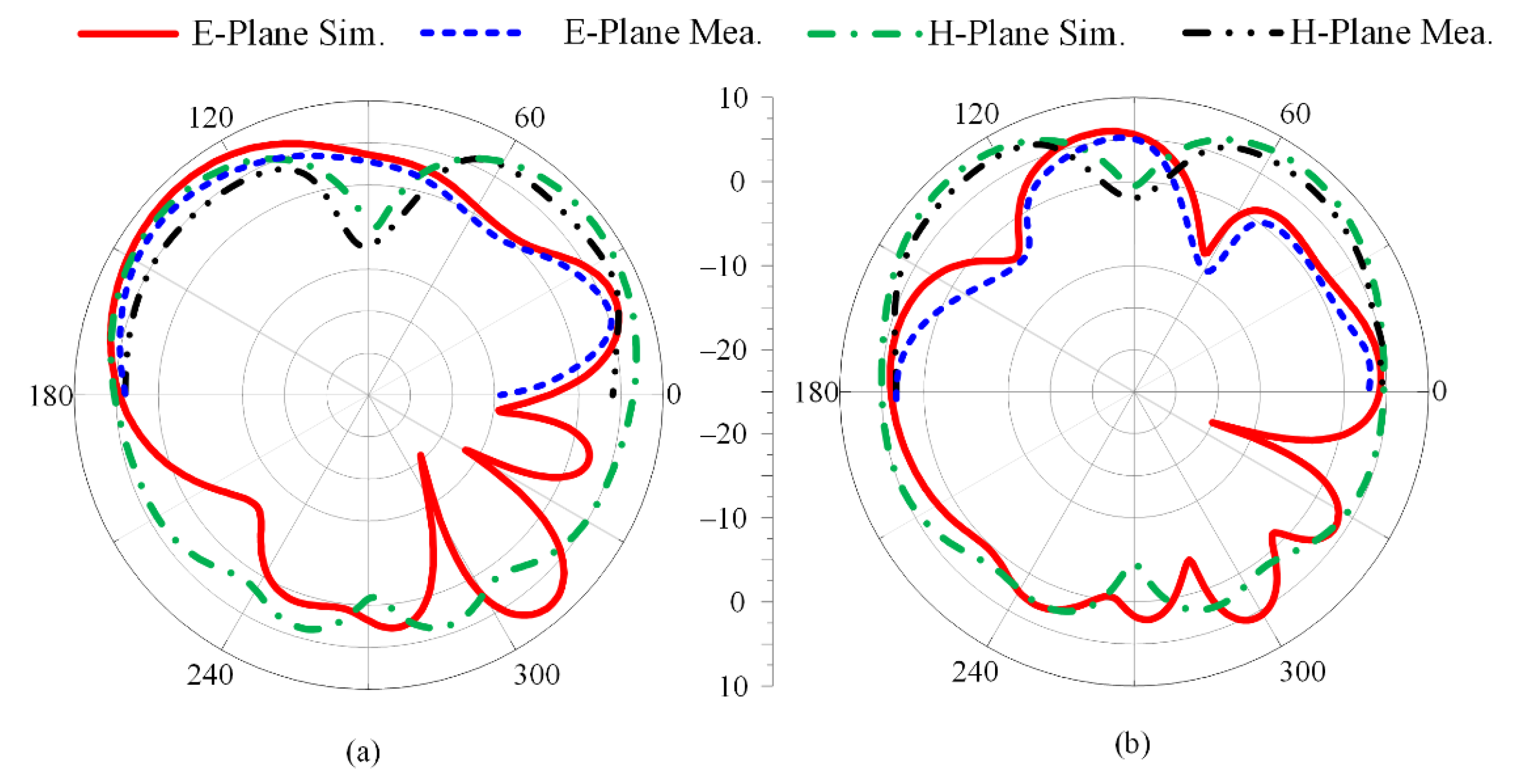
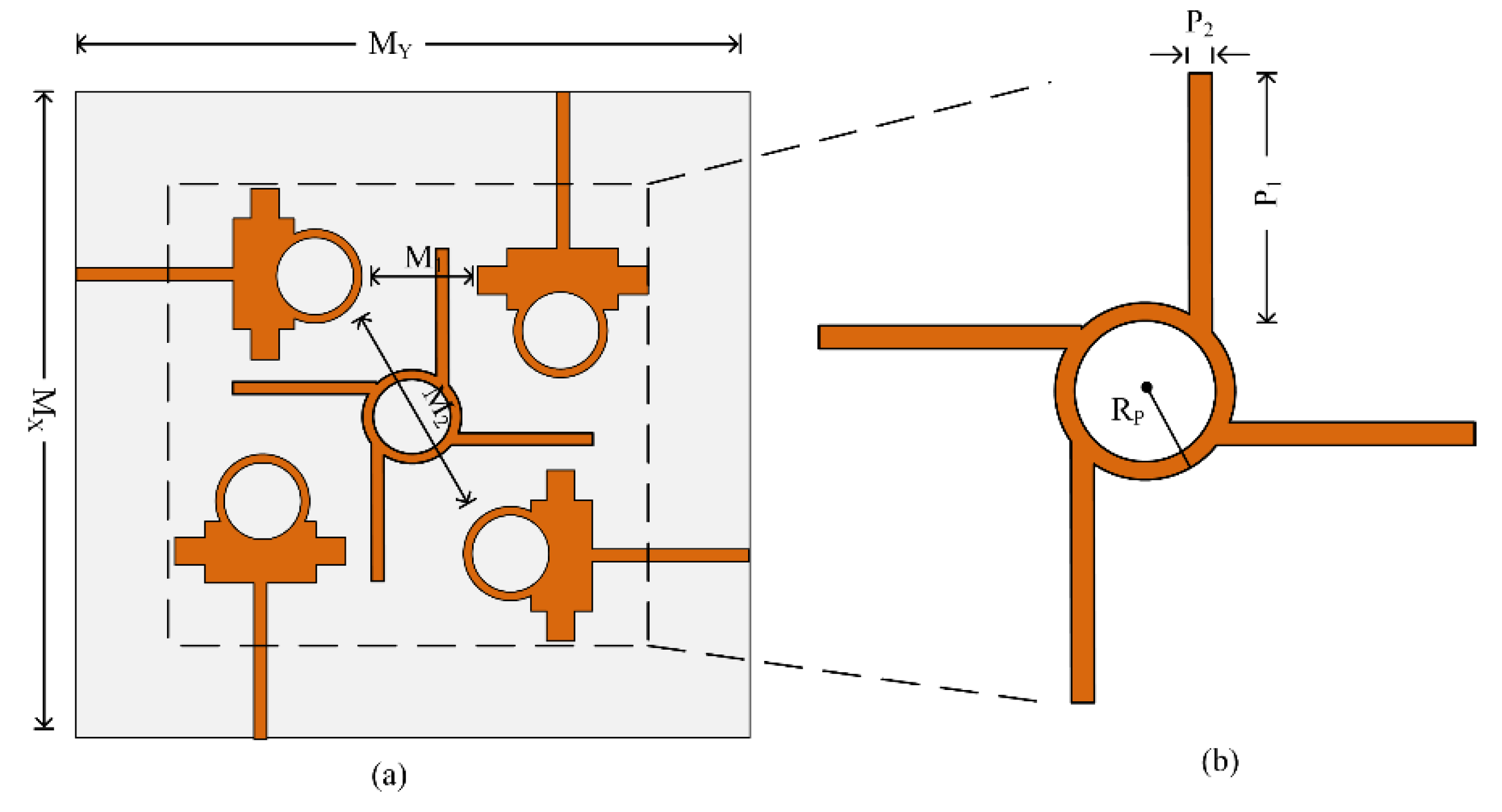

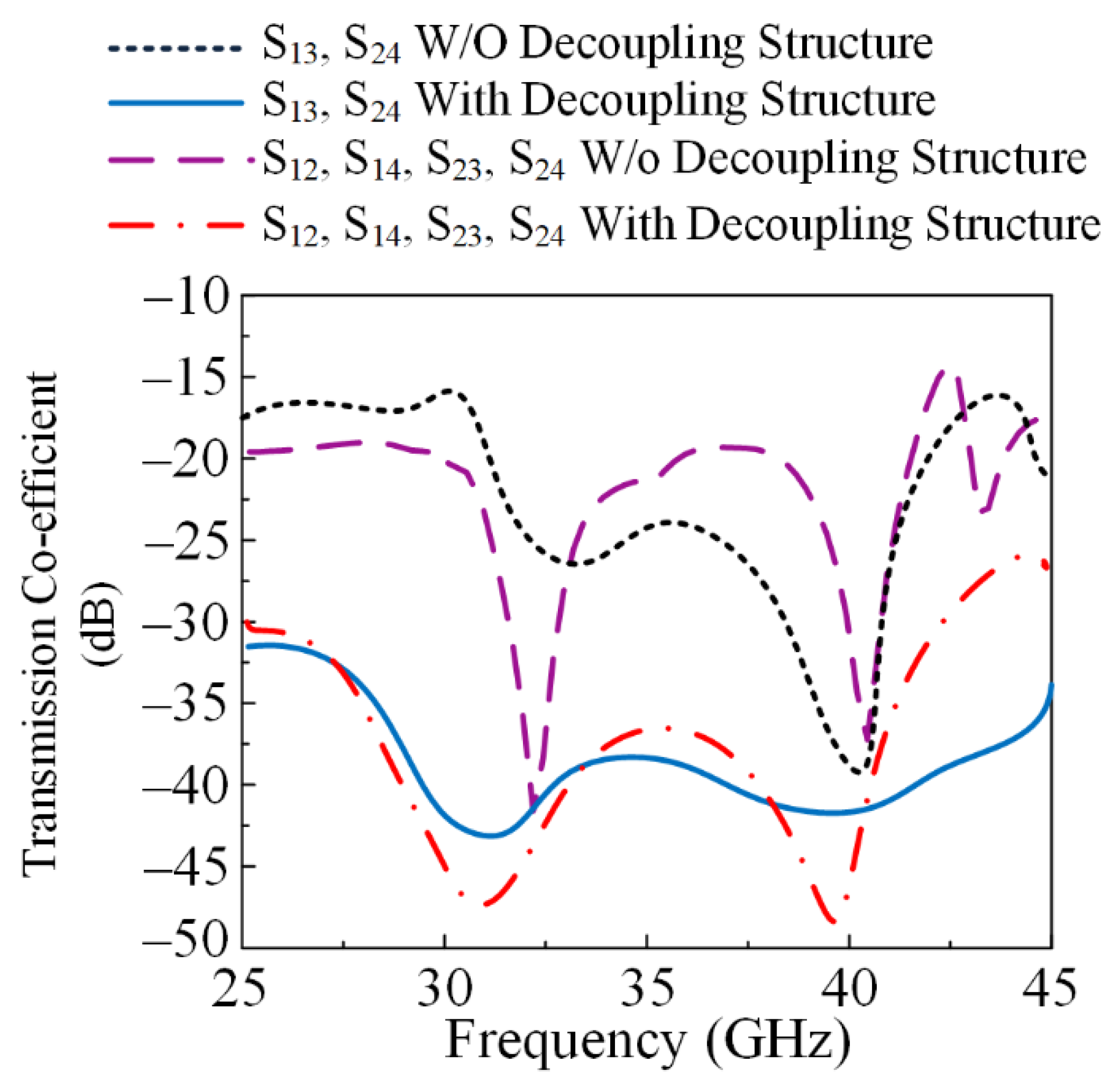

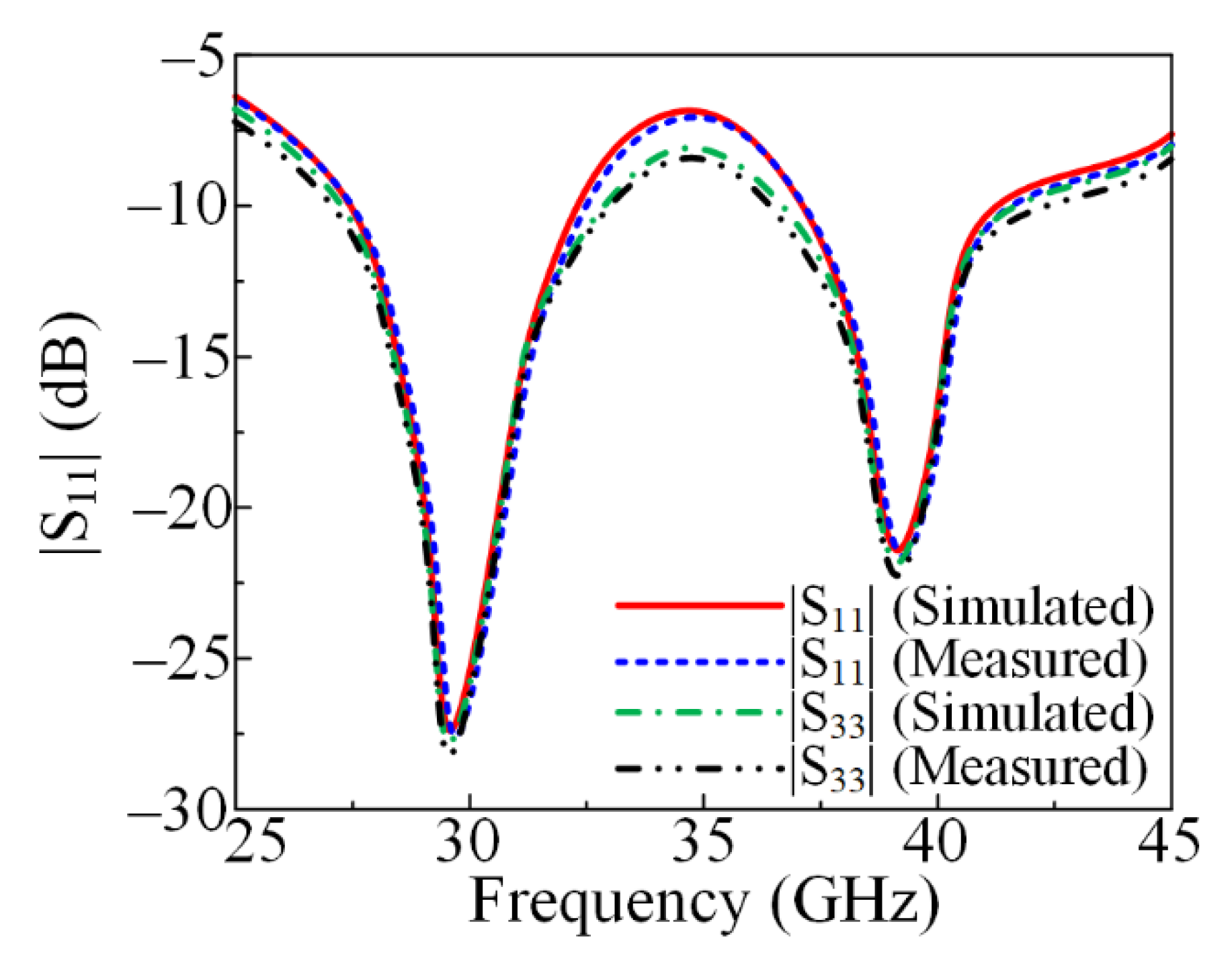
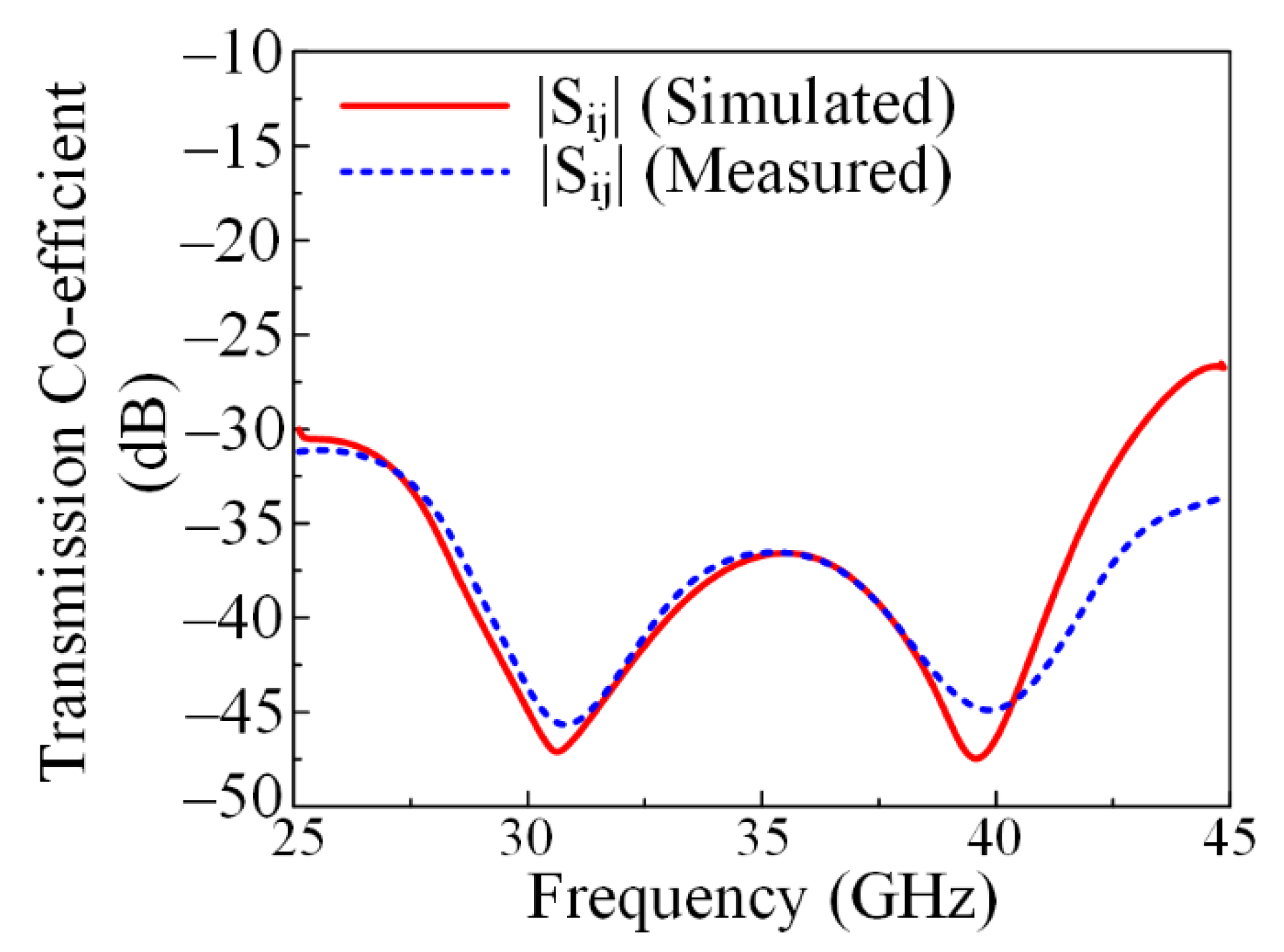
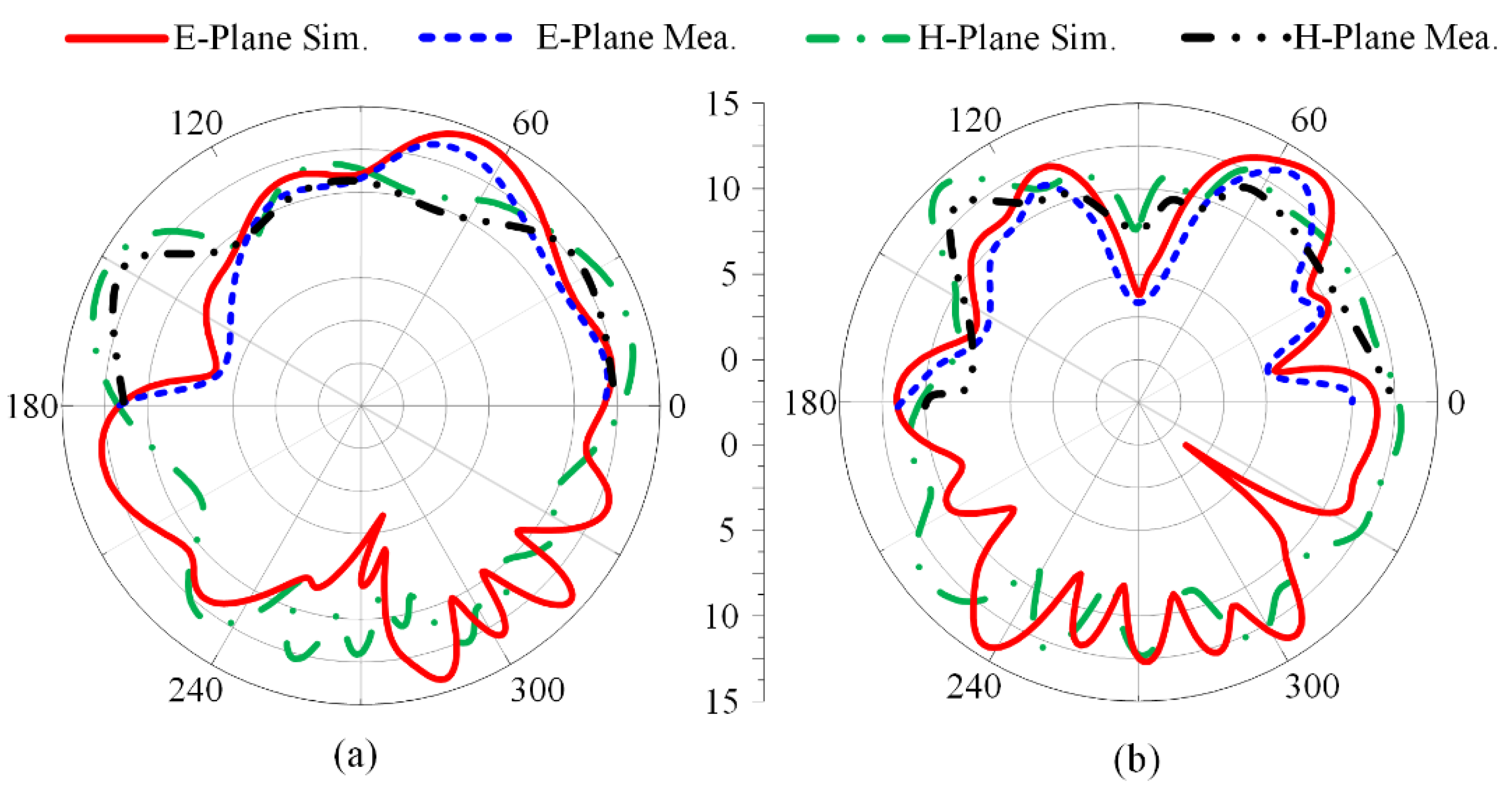



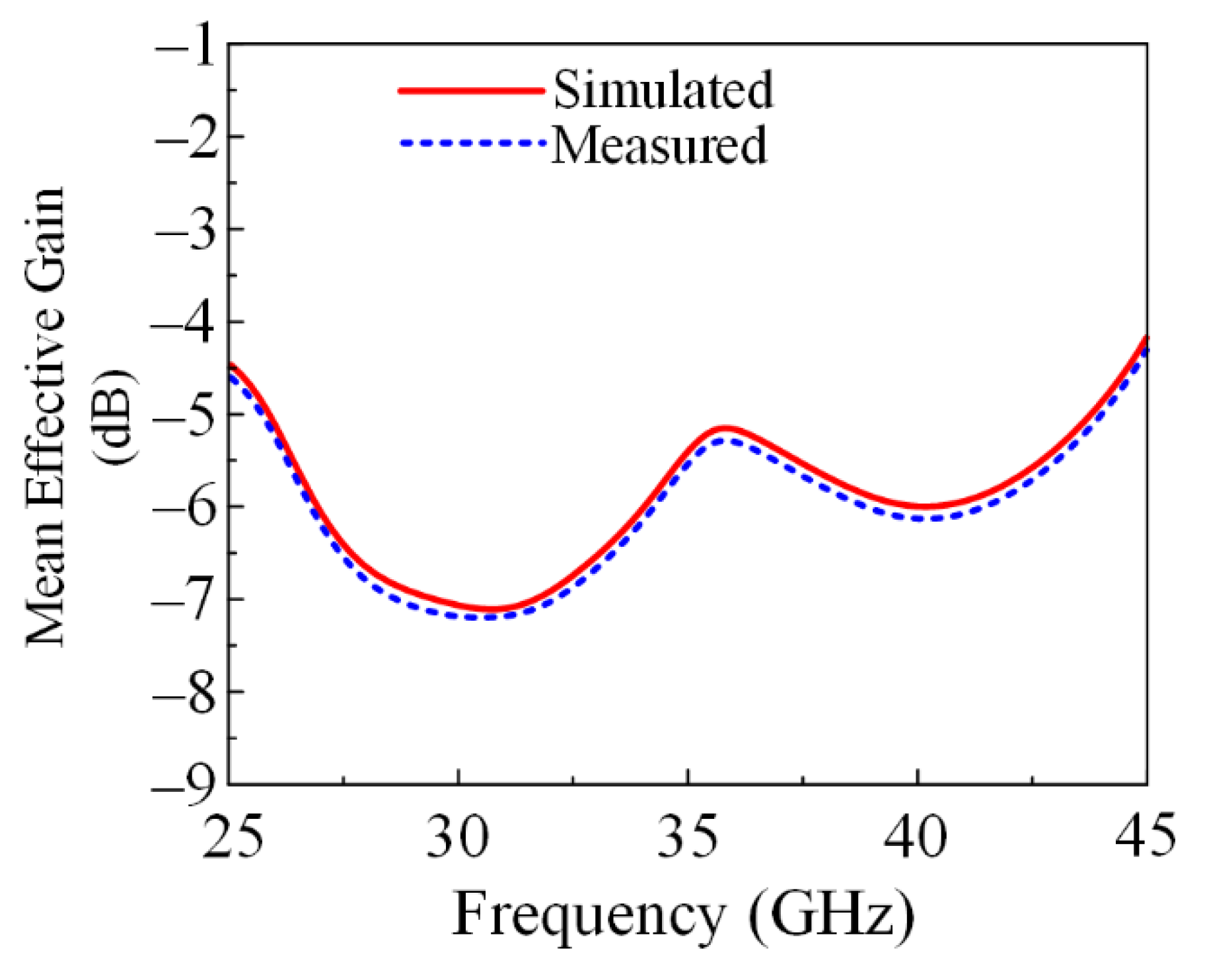
| Ref. | Overall Antenna Size (mm × mm) | Operational Frequencies (GHz) | Antenna Type | Operational Bandwidth (GHz) | Gain (dBi) |
|---|---|---|---|---|---|
| [6] | 5 × 5 | 28 | Printed antenna | 26.5–29 | 6.5 |
| [8] | 90.49 × 29.43 | 38 | Array antenna | 31–39 | 16.4 |
| [9] | 21 × 26 | 28/38 | Enhanced Franklin antenna | 24–30 34–40 | 4.2 6.9 |
| [10] | 5 × 5 | 28/38 | Patch antenna | 27.5–29 37–38.5 | 6.6 5.6 |
| [11] | 6.2 × 8.4 | 28 | Patch antenna | 26–31 | 3 |
| [12] | 12 × 18 | 28/38 | Patch antenna | 26–29 37–40 | 6.6 7 |
| Prop. Design | 13 × 15 | 28/38 | Patch antenna | 26–31.5 36.5–41.7 | 7 8.25 |
| Ref. | Overall Antenna Size (mm3) | Operational Frequencies (GHz) | Operational Bandwidth (GHz) | Max Isolation without Parasitic Element (dBi) | Max Isolation with Parasitic Element (dBi) | Gain (dBi) | Technique Adopted for Isolation Improvement |
|---|---|---|---|---|---|---|---|
| [22] | 20 × 40 × 1.6 | 27 | 26.7–28.9 | −−16 | −29.3 | 5.6 | Metamaterial structure |
| [23] | 15.3 × 8.5 × 0.79 | 27/38 | 28.5–29.5 37.5–38.45 | −52 | −60 | 6.19 7.16 | Double-sided EBG structure |
| [24] | 20 × 20 × 2.794 | 28 | 27.5–28.5 | −22 | −34 | 8.2 | Metallic strip |
| [25] | 15 × 26 ×1.57 | 15 | 15.5–17 | −25 | −38 | 9.8 | Parasitic element |
| [26] | 25 × 15 × 1 | 28/38 | 26.5–31 36–40 | −22 | −44 | 6.2 5.8 | DRA |
| [27] | 5 × 57.5 × 0.508 | 24/28 | 23.3–25.2 26.9–29 | −16 −17 | −20 −24 | 18 16.02 | Additional stub-loaded patch antenna |
| This work | 28 × 28 × 0.79 | 28/38 | 26.5–31.5 36–41.7 | −40 | −50 | 9.5 11.5 | Parasitic element |
Publisher’s Note: MDPI stays neutral with regard to jurisdictional claims in published maps and institutional affiliations. |
© 2022 by the authors. Licensee MDPI, Basel, Switzerland. This article is an open access article distributed under the terms and conditions of the Creative Commons Attribution (CC BY) license (https://creativecommons.org/licenses/by/4.0/).
Share and Cite
Hussain, M.; Awan, W.A.; Ali, E.M.; Alzaidi, M.S.; Alsharef, M.; Elkamchouchi, D.H.; Alzahrani, A.; Fathy Abo Sree, M. Isolation Improvement of Parasitic Element-Loaded Dual-Band MIMO Antenna for Mm-Wave Applications. Micromachines 2022, 13, 1918. https://doi.org/10.3390/mi13111918
Hussain M, Awan WA, Ali EM, Alzaidi MS, Alsharef M, Elkamchouchi DH, Alzahrani A, Fathy Abo Sree M. Isolation Improvement of Parasitic Element-Loaded Dual-Band MIMO Antenna for Mm-Wave Applications. Micromachines. 2022; 13(11):1918. https://doi.org/10.3390/mi13111918
Chicago/Turabian StyleHussain, Musa, Wahaj Abbas Awan, Esraa Musa Ali, Mohammed S. Alzaidi, Mohammad Alsharef, Dalia H. Elkamchouchi, Abdullah Alzahrani, and Mohamed Fathy Abo Sree. 2022. "Isolation Improvement of Parasitic Element-Loaded Dual-Band MIMO Antenna for Mm-Wave Applications" Micromachines 13, no. 11: 1918. https://doi.org/10.3390/mi13111918
APA StyleHussain, M., Awan, W. A., Ali, E. M., Alzaidi, M. S., Alsharef, M., Elkamchouchi, D. H., Alzahrani, A., & Fathy Abo Sree, M. (2022). Isolation Improvement of Parasitic Element-Loaded Dual-Band MIMO Antenna for Mm-Wave Applications. Micromachines, 13(11), 1918. https://doi.org/10.3390/mi13111918









